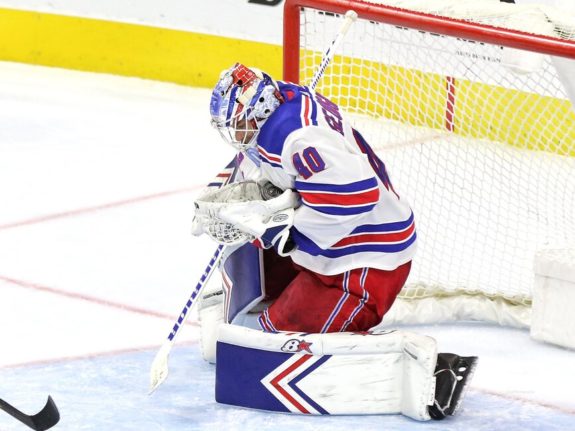It was a thrilling 5-4 victory for the New York Rangers over the Buffalo Sabres at Madison Square Garden Sunday night. The chaos ended when Ryan Lindgren polished off a Mika Zibanejad feed with 0.4 seconds left in the game in another disappointing night for Alexandar Georgiev.
The 25-year old goaltender allowed four goals on 18 shots before getting pulled by head coach Gerard Gallant at the start of the third period. Gallant was coy in his postgame response about the decision to remove Georgiev from the game, stating it was a “coach’s decision,” per Larry Brooks of the New York Post (from ‘Rangers finding ways to win doesn’t change their Alex Georgiev problem,’ Larry Brooks, New York Post, 11/22/21).
Georgiev now has a 4.08 goals-against average (GAA), and a .858 save percentage (SV%) on the season. Only Anton Forsberg of the Ottawa Senators has a higher GAA (4.56) amongst goaltenders with at least five games played, and no goaltender (with five games played) has a lower save percentage than Georgiev’s .858, which ranks 54th in the league.

The Rangers have Shesterkin, their workhorse, but the Russian-born goaltender has never been tasked with starting as many games as often as he will be this season. Spelling their starter is key to the Rangers’ long-term success, but the lack of trust in their backup complicates matters.
President and general manager Chris Drury have already demonstrated he is unwilling to lose an asset for nothing via waivers as he did with Libor Hajek. But as the trade market thins with each appearance from Georgiev, the Rangers have backed themselves into a corner.
Rangers’ Options For Georgiev
To waive or not to waive Georgiev? That is the million-dollar question right now. Ideally, they would trade him and acquire an asset in return. But after failing to find any dance partners last offseason, the hopes of getting anything more than a B-level prospect or a low draft pick in return seem bleak.
A trade, at this point, is a win-win for both sides. Georgiev would get a fresh start, and the Rangers would be able to resolve their backup woes. Finding a team interested in a goaltender with a career GAA of 3.01 is no simple task, but age is on Georgiev’s side. Could Drury find a team interested in taking a chance on a young, affordable goaltender? Yes. But the market for him at the moment is microscopic at best.
Option B is to place Georgiev on waivers. If he clears the wire, he can try to rebuild his confidence with the Hartford Wolf Pack, which will also allow the Rangers to keep his rights in the hopes that an impressive stint in the American Hockey League might reclaim some of his earlier value.
Related: Rangers’ Trouba Is Finally Living Up To Contract Expectations
Either option presents an opening for Keith Kinkaid, the Wolf Pack’s starting goaltender right now. Boasting an 8-1-1 record in 2021-22, the New York native is playing with confidence. He also has a 2.55 GAA and a .918 SV%, bringing a calming and veteran presence to the locker room. Kinkaid saw time with the Rangers in 2020-21, posting a 2.59 GAA and .898 SV% in nine games.
Kinkaid is a veteran goaltender with stints in the NHL with the New Jersey Devils, Columbus Blue Jackets, Montreal Canadiens, and Rangers. But the Blueshirts could also go with a homegrown option in Adam Huska, who they selected in the seventh round back in 2015. He has played five games for Hartford thus far, with an impressive 1.81 GAA and a .938 SV%.
But first, something has to be done with Georgiev. Although a move doesn’t seem imminent, the clock is ticking on number 40’s time with the Rangers.
Diving Further Into Georgiev’s Struggles
Georgiev’s analytics are eye-opening. A quality start in the NHL is when a goaltender finishes the night with an above-average save percentage relative to the league average. In five games this season, he has one quality start and has already tied his mark from 2020-21 with three bad starts (or games with a save percentage below .850, per hockey reference).
His latest outing against the Sabres was no different, posting a save percentage of .778. MSG analyst and former Rangers’ netminder, Stephen Valiquette, brilliantly draws on analytics in a way that everyone can understand. In partnership with CSA Hockey, Valiquette posts advanced goaltending stats every postgame, and after Sunday night’s win, it’s clear that the Rangers will have to outscore their opponent and their goaltender.
After a sloppy first period, the Rangers outplayed and out-chanced the Sabres, piling up an expected-goals for of 4.97 compared to the Sabres’ 1.90. Yet the final score was 5-4, with a last-second goal providing the difference. If games that Shesterkin doesn’t start become shoot-outs like this one, the Rangers wind up in deep water against better teams.
The trend is troubling and consistent when Georgiev starts. Among qualified goaltenders, his -7.65 goals saved above average (GSAA) is only ahead of the Seattle Kraken’s Philipp Grubauer (-11.25). Of 79 goaltenders who have started a game this season, Georgiev’s quality starts of 20% rank 68. At all strengths, Georgiev has a .679 high-danger save percentage, the lowest mark among goaltenders with over 200 minutes played, per Natural Stat Trick.
However you slice it, he has not been good enough for the Rangers. His performance must force Drury to make a decision: Do they ride out this cold spell rather than making a move, or do they take a chance on waiving him to provide immediate relief?
